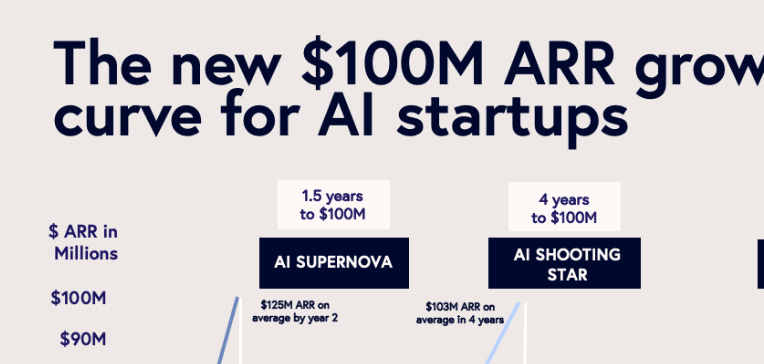🛑 Stop the $100M-in-Year-One Panic: A Reality Check for Seed Founders
The real danger of measuring your early-stage company against somebody else’s marketing graph
Bessemer’s recent “State of AI 2025” report lays out some truly dazzling benchmarks that are echoing in startup and VC firm hallways: “Supernova” AI startups hit $100M ARR in just 1.5 years”. Even slower-growth “Shooting Stars” blow past $100M in just 4 years. From Bessemer’s report:

Unsurprisingly, pre-seed and seed founders are now asking me if they’re “already behind.” They’re not. The framing is. It makes for great VC content marketing and punchy headlines—big numbers, big momentum, big clicks—but it also has real downstream consequences. Early-stage founders absorb these benchmarks as gospel, reshape their expectations around them, and quietly panic when they don’t see a path to $40M ARR twelve months after starting their company. That’s the part nobody writing these reports ever seems to wrestle with.
The misleading bit
“Year one of commercialization” is a clever escape hatch. It lets any founder or VC pick when the clock starts, so you can be three years post-incorporation, still developing product, declare “year one commercialization” when you finally sell something—and then you’re measured. In short: the benchmark is malleable.
Despite this, the report lays out “top takeaways for founders” that the 2 winning patterns are either “hit ~$100M ARR in 1.5 years” or “$3M to $100M over 4 years”, implying that seed-stage founders must aim for those numbers or pack up their things and go home. That subtly scares entrepreneurs into believing: fall short = failure.

The real impact
For seed founders—especially in the “software beyond the screen” category that we love at Ubiquity—this framing is demoralizing and counterproductive. Many of the most durable deeptech and real-world AI companies succeed by doing the opposite of sprinting: they nail customer development, build patiently, test deeply, integrate carefully, and then scale fast once the foundation is solid.
And this approach works. Halter (cows), Loft Orbital (satellites), Esper (devices), BusRight (school buses), Eyebot (optical prescriptions) and others in the Ubiquity portfolio are scaling beautifully—but only because they first invested in unglamorous and patient work.
The early years of these Ubiquity companies didn’t look like “Supernova” charts. They looked like thoughtful, disciplined company-building.
Chasing someone else’s clock leads to forced scaling, thin margins, and artificial pressure—exactly the opposite of building a durable, defensible business.
The Ubiquity view
Don’t panic. You do not need $100M ARR within 4 years of incorporation to be “on track.”
Define your own start line. Be explicit about when commercialization actually begins—not when a benchmark report suggests it does.
Prioritize durability. Real businesses have happy, engaged customers. This customer love shows up in retention, expanding usage, and margin improvement. Customer love can also mean a customer tattooing your company’s logo on their leg as a BusRight customer did.
Use catchy VC benchmarks with caution. They’re outer bounds, not moral imperatives.
Final word: “Don’t compare your beginning to someone else’s middle.”
Founders: Most “year zero” stories come from companies that have quietly been building for years. If you’re newly incorporated, comparing your literal Day 1 to someone else’s multi-year “year one of commercialization” is not just unfair—it’s delusional. Don’t let glossy charts dictate your self-worth.
Pace yourself, build something defensible, and let your velocity be earned rather than forced.
Ubiquity Ventures — led by Sunil Nagaraj — is a seed-stage venture capital firm focused on startups solving real-world physical problems with "software beyond the screen", often using smart hardware or machine learning.
If your startup fits this description, reach out to us.


